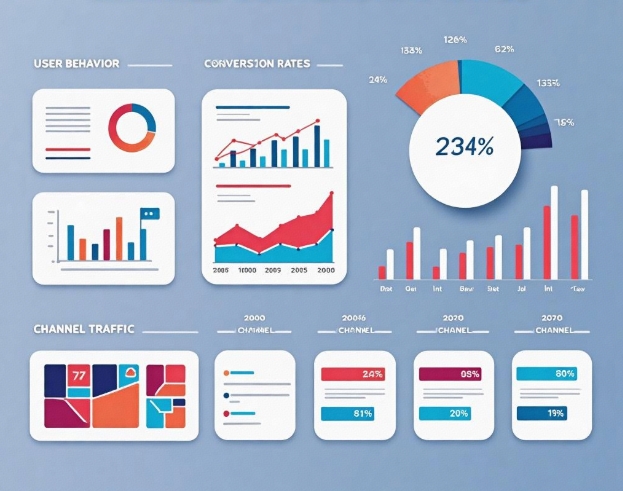How to increase channel conversion rate by 30% in distribution system development?
- latest articles
- 1.DApp Development & Customization: Merging Diverse Market Needs with User Experience 2.Analysis of the Core Technical System in DApp Project Development 3.How to achieve cross-chain interoperability in Web3 projects? 4.How does the tokenization of points reconstruct the e-commerce ecosystem? 5.How to Set and Track Data Metrics for a Points Mall? 6.What is DApp Development? Core Concepts and Technical Analysis 7.Inventory of commonly used Web3 development tools and usage tips 8.Development of a Distribution System Integrated with Social E-commerce 9.Six Key Steps for Businesses to Build a Points Mall System 10.What is DApp Development? A Comprehensive Guide from Concept to Implementation
- Popular Articles
- 1.Future Trends and Technology Predictions for APP Development in 2025 2.Analysis of the DeFi Ecosystem: How Developers Can Participate in Decentralized Finance Innovation 3.From Zero to One: How PI Mall Revolutionizes the Traditional E-commerce Model 4.DAPP Development | Best Practices for Professional Customization and Rapid Launch 5.Recommended by the Web3 developer community: the most noteworthy forums and resources 6.How to Develop a Successful Douyin Mini Program: Technical Architecture and Best Practices 7.From Cloud Computing to Computing Power Leasing: Building a Flexible and Scalable Computing Resource Platform 8.Shared Bike System APP: The Convenient Choice in the Era of Smart Travel 9.How to Create a Successful Dating App: From Needs Analysis to User Experience Design 10.From Design to Development: The Complete Process of Bringing an APP Idea to Life
In today's highly competitive market environment, how to improve channel conversion rates has always been a crucial challenge for businesses during their development. Especially as traditional sales models gradually transition to digital transformation, the development of distribution systems has become a key initiative to enhance channel conversion rates. Through scientifically designed distribution systems, companies can optimize sales processes, boost the motivation of channel partners, and thereby achieve rapid growth in sales conversions. So, how can the development of a distribution system help businesses increase their channel conversion rate by 30%? This article will explore the core functions, feature design, and optimization strategies of distribution systems.
I. The Core Functions of Distribution Systems
A distribution system is a tool and platform through which a company provides products or services to end customers via third-party channels (such as agents, distributors, wholesalers, etc.). A well-designed distribution system is not just a sales management tool but also a powerful instrument for improving channel conversion rates and enhancing sales execution.
The core functions of a distribution system are mainly reflected in the following aspects:
Accurate Channel Management: A distribution system can effectively manage the information and orders of multiple channel partners, helping companies keep track of sales performance across various channels in real-time and ensuring the rational allocation and utilization of resources. By evaluating the performance of channel partners, companies can adjust their distribution strategies promptly to improve conversion rates.
Data-Driven Decision Support: Through big data analysis, a distribution system can accurately capture channel performance, identify which channels have lower conversion rates, and use data mining to determine the causes, providing a basis for improvement strategies. With data feedback, companies can flexibly adjust marketing strategies and resource allocation to maximize channel conversion rates.
Efficient Order and Inventory Management: A distribution system enables real-time inventory management, ensuring timely and accurate product supply. Channel partners can access the latest inventory information through the system, avoiding sales bottlenecks caused by stock issues, thereby enhancing sales efficiency and conversion rates.
Automated Processes to Boost Efficiency: Through a distribution system, companies can automate a series of sales processes such as order processing, payment settlement, and logistics delivery, significantly reducing the complexity of manual operations, improving efficiency, and minimizing the risk of conversion rate drops due to operational errors.
Enhancing Channel Partner Engagement: A well-designed distribution system can provide visual sales data, helping channel partners understand their sales performance and target progress in real-time, thereby increasing their motivation and engagement. This transparent management not only builds trust among channel partners but also encourages them to actively promote product sales, ultimately improving conversion rates.
II. How Does Distribution System Feature Design Enhance Channel Conversion Rates?
During the development of a distribution system, feature design is crucial. A comprehensive distribution system not only improves efficiency but also provides strong support for enhancing channel conversion rates. Here are several key feature designs that can help businesses boost channel conversion rates:
Support for Multi-Level Distribution Models: Many companies adopt multi-level distribution models, where agents can resell products to sub-agents or end consumers. Therefore, the distribution system needs to support multi-level distribution management, facilitating resource allocation and monitoring across different levels. This design not only boosts the motivation of channel partners but also encourages them to invest more effort into sales activities.
Flexible Commission and Incentive Mechanisms: A distribution system can integrate flexible commission calculations and incentive mechanisms, allowing companies to set different commission rates and reward structures based on varying sales scenarios, targets, and partner levels. Through systematic and transparent reward mechanisms, it effectively stimulates the sales enthusiasm of channel partners, promoting higher conversion rates.
Real-Time Inventory and Price Updates: Real-time updates of inventory and pricing are essential features of a distribution system. Companies can monitor product stock levels and price adjustments for promotions in real-time, ensuring that channel partners receive the latest sales information promptly. This real-time capability prevents missed sales opportunities due to information delays, thereby improving conversion rates.
Precise Customer Management Features: Through Customer Relationship Management (CRM) functionality, a distribution system helps channel partners accurately understand customer needs and preferences for targeted marketing. By analyzing customers' purchase history and behavioral data, channel partners can create personalized sales plans and services, increasing customer purchase intent and loyalty, and thus enhancing conversion rates.
Data Visualization and Reporting Features: With the data analysis and reporting capabilities provided by a distribution system, channel partners can intuitively understand key information such as their sales data, market performance, and product movement. This data visualization not only aids in sales decision-making but also helps identify issues in the sales process for timely adjustments, thereby improving conversion rates.
Intelligent Recommendations and Marketing Tools: Leveraging big data and artificial intelligence, a distribution system can provide channel partners with intelligent recommendations and precise marketing tools. For example, by analyzing consumer purchasing behavior, the system can suggest related products or promotions, helping channel partners deploy the most effective marketing strategies at the right time to drive sales conversions.
III. Strategies for Optimizing Distribution Systems to Enhance Channel Conversion Rates
To better improve channel conversion rates, companies developing distribution systems should not only focus on feature design but also incorporate optimization strategies to comprehensively enhance sales efficiency and conversion effectiveness.
Enhancing Distributor Training and Support: Improving channel conversion rates relies not only on the system itself but also on the support provided to channel partners. Regular training, market information, and marketing guidance can effectively enhance their sales capabilities. A well-trained and supported channel partner network can quickly adapt to market changes and improve sales performance.
Optimizing Distributor Incentive Policies: The commission mechanisms and reward policies in a distribution system need to be flexibly adjusted to meet changing market conditions and sales targets. By setting reasonable sales goals and offering attractive commission rewards, companies can effectively motivate channel partners, thereby boosting conversion rates.
Strengthening Partnerships with Channel Partners: The design of a distribution system should not only control the sales process but also provide a better collaborative experience for channel partners. Companies can use the system to build closer partnerships, share market resources and information, enhance mutual trust and cooperation, and ultimately improve overall channel conversion rates.
Personalized Marketing and Targeted Outreach: With the application of big data and AI, distribution systems can offer personalized marketing plans based on customer purchasing behavior and preferences. This targeted marketing not only increases customer purchase intent but also helps channel partners achieve better sales conversions.
Strengthening After-Sales Service and Customer Relationship Maintenance: Excellent after-sales service is crucial for improving channel conversion rates. A distribution system can assist channel partners in managing after-sales services more efficiently, such as handling customer complaints and follow-ups. By optimizing after-sales processes, customer satisfaction and loyalty are enhanced, ultimately driving higher conversion rates.
IV. Conclusion
As a vital tool for enhancing channel conversion rates, the development and optimization of distribution systems play a critical role in market competition. Through precise channel management, flexible incentive mechanisms, real-time inventory information, data visualization, and intelligent marketing features, distribution systems can significantly boost the motivation and sales efficiency of channel partners, thereby increasing conversion rates. When developing a distribution system, companies should not only focus on comprehensive functionality but also align with actual market demands and adjust strategies flexibly. Through dual optimization of the system and strategies, businesses can fully achieve the goal of increasing channel conversion rates by 30%, securing a more advantageous position in the fiercely competitive market.
-

How does the tokenization of points reconstruct the e-commerce ecosystem?
With the continuous advancement of internet technology and the gradual prolifera···
-

How to Set and Track Data Metrics for a Points Mall?
With the rapid development of the e-commerce industry, points malls, as a common···
-

Development of a Distribution System Integrated with Social E-commerce
With the rapid development of internet technology, the e-commerce industry has e···

 Blockchain
Blockchain












